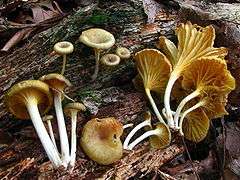Gerronema
Gerronema is a genus of small- to medium-sized lignicolous agarics with white, nonamyloid, spores and decurrent gills.[1][2][3] The genus was circumscribed by American mycologist Rolf Singer in 1951.[4]
| Gerronema | |
|---|---|
 | |
| Gerronema strombodes | |
| Scientific classification | |
| Kingdom: | |
| Division: | |
| Class: | |
| Order: | |
| Family: | |
| Genus: | Gerronema Singer (1951) |
| Type species | |
| Gerronema melanomphax Singer (1951) | |
Description
Typically the cap of the fruit bodies have a shallow to deep central depression, giving the umbrella-like to funnel-shaped caps the appearance of a belly button, or a belly with a navel. Similarly shaped agarics are said to be omphalinoid in appearance in reference to a morphologically similar genus, Omphalina. Gerronema differ from Omphalina by the absence of incrusting or intraparietal pigments typical of Omphalina, the occasional occurrence of bright colors, such as yellow or green absent in Omphalina, by the restriction to decay of wood, and by the tough tissues composed of sarcodimitic hyphae.
Distribution
The species have a primarily tropical distribution, but also occur in Europe and eastern North America where they fruit during hot muggy, summer weather. One of the most common species in the eastern United States is Gerronema strombodes .
Species
As of June 2015, Index Fungorum lists 55 species in Gerronema:[5] and a new combination was published in 2019.[6]
- G. aconquijense
- G. albidum
- G. albogriseolum
- G. alutaceum
- G. amabile
- G. atrialba
- G. bethlehemicum
- G. brunneum
- G. bryogeton
- G. calongei
- G. candidum
- G. chrysocarpum
- G. chrysocraspedum
- G. cinctum
- G. citrinum
- G. collybiomorphum
- G. corticiphilum
- G. costaricense
- G. cyathiforme
- G. daamsii
- G. daguense
- G. farinolens
- G. fibula
- G. flammeum
- G. glutinipes
- G. hungo
- G. incarnatum
- G. infumatum
- G. josserandii
- G. laccarioides
- G. longipes
- G. majus
- G. mariae
- G. melanomphax
- G. moseri
- G. nemorale
- G. nitriolens
- G. oligophyllum
- G. pantoxanthum
- G. pseudomurale
- G. reclinis
- G. sanguineum
- G. schusteri
- G. sericeum
- G. stevensonii
- G. strombodes
- G. subchrysophyllum
- G. subclavatum
- G. suboreades
- G. subsericellum
- G. sucrense
- G. tenue
- G. theophili
- G. umbilicatum
- G. virgineum
- G. viridilucens (bioluminescent)
- G. xanthophyllum
References
- Redhead SA, Moncalvo J-M, Vilgalys R, Lutzoni F (2002). "Phylogeny of agarics: partial systematics solutions for bryophilous omphalinoid agarics outside of the Agaricales (euagarics)". Mycotaxon. 82: 151–168.
- Redhead SA, Lutzoni F, Moncalvo J-M, Vilgalys R (2002b). "Phylogeny of agarics: partial systematics solutions for core omphalinoid genera in the Agaricales (euagarics)". Mycotaxon. 83: 19–57.
- Norvell LL, Redhead SA, Ammirati JF (1994). "Omphalina sensu lato in North America. 1-2: 1: Omphalina wynniae and the genus Chrysomphalina. 2: Omphalina sensu Bigelow". Mycotaxon. 50: 379–407.
- Singer R. (1951). "New genera of fungi V". Mycologia. 43 (5): 598–604. doi:10.2307/3755431. JSTOR 3755431.
- Kirk PM. "Species Fungorum (version 26th May 2015). In: Species 2000 & ITIS Catalogue of Life". Retrieved 2015-06-20.
- Antonín V, Borovička J, Holec J, Piltaver A, Kolařík M (2019). "Taxonomic update of Clitocybula sensu lato with a new generic classification". Fungal Biology. 123 (6): 431–447. doi:10.1016/j.funbio.2019.03.004.